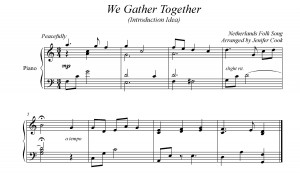Free Piano Arrangement: Christ Returneth Part One (congregational style)
Sunday, April 10th, 2011I’ve had my computer off because of our weather and now back online. Sorry for the late posting. Since I’m short on time…I only entered the soprano for the vocal score of “Christ Returneth” to help you follow the words while you play the piano accompaniment.
I think “Christ Returneth” is one of the most awkward hymns to play when accompanying the four part harmony from the hymnal. Due to the frequent chord changes, the church pianist only needs to create a simple, but stately accompaniment to enrich the text.
Notice the time signature changes during the verse. The verses are sudued and the chorus is jubilant. The congregation will enter with confidence if they hear how the song starts in the piano introduction.
To maintain the subdued mood of the verse, the church pianist can just play the beginning phrase of the verse followed by a improvised ending…creating a smooth transition for the congregation to begin singing. I did include an introduction in today’s free arrangement of “Christ Returneth” Part One
Click here to download free piano arrangement of: Christ Returneth (Part One)
 Part One of Sunlight
Part One of Sunlight

